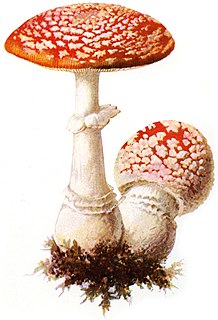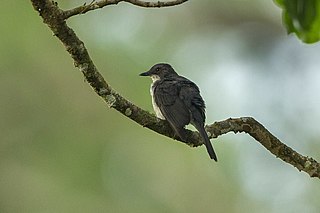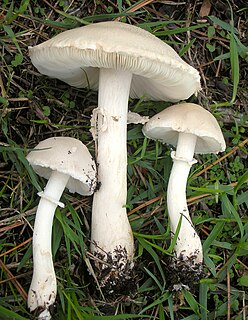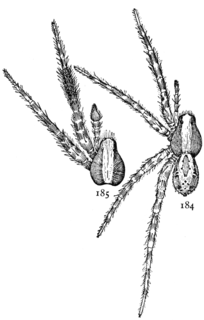Related Research Articles
Angel of Death may refer to:

The genus Amanita contains about 600 species of agarics, including some of the most toxic known mushrooms found worldwide, as well as some well-regarded edible species. This genus is responsible for approximately 95% of the fatalities resulting from mushroom poisoning, with the death cap accounting for about 50% on its own. The most potent toxin present in these mushrooms is α-amanitin.
Death angel may refer to:

The African wildcat is a small wildcat species native to Africa, West and Central Asia up to Rajasthan in India and Xinjiang in China. The IUCN Red List status Least Concern is attributed to the species Felis silvestris, which at the time of assessment also included the African wildcat as a subspecies.

Amanita calyptroderma also known as coccora, coccoli or the Pacific amanita, is a white-spored mushroom that fruits naturally in the coastal forests of the western United States during the fall and winter and spring.

Amanita velosa or bittersweet orange ringless amanita is an edible species of agaric found in California, as well as southern Oregon and Baja California.

Amanita ocreata, commonly known as the death angel, destroying angel, angel of death or more precisely western North American destroying angel, is a deadly poisonous basidiomycete fungus, one of many in the genus Amanita. Occurring in the Pacific Northwest and California floristic provinces of North America, A. ocreata associates with oak trees. The large fruiting bodies generally appear in spring; the cap may be white or ochre and often develops a brownish centre, while the stipe, ring, gill and volva are all white.

Pierella is a butterfly genus from the subfamily Satyrinae in the family Nymphalidae found from Mexico through Central America to South America. The species of Pierella have larger hindwings than forewings, unique among butterflies. The oval green flash on the forewing is also unique. It is caused by diffraction, the wing scales forming a diffraction grating.

Fraseria is a genus of passerine birds in the Old World flycatcher family Muscicapidae. It contains the following species:

Fraser's forest flycatcher, also known as the African forest-flycatcher, is a species of bird in the family Muscicapidae. It is found throughout the intra-tropical rainforest of Sub-Saharan Africa.

Leucoagaricus leucothites, the white dapperling, or white Agaricus mushroom, is a species of agaric fungus. The species was originally described as Agaricus leucothites by Carlo Vittadini in 1835, and bears similarity to species of that genus. Solomon Wasser transferred it to Leucoagaricus in 1977. While sometimes regarded as edible, the species is suspected of being poisonous due to gastric-upset-causing toxins. It could also be confused with the deadly Amanita ocreata.

Deltoplastis is a genus of moths in the family Lecithoceridae. The genus was erected by Edward Meyrick in 1925.

Pierella helvina, the red-washed satyr, is a species of nymphalid butterfly, belonging to subfamily Satyrinae.
Piampatara is a genus of longhorn beetles of the subfamily Lamiinae, containing the following species:
Deltoplastis ocreata is a moth in the family Lecithoceridae. It was described by Edward Meyrick in 1910. It is found in southern India.
Piampatara humeralis is a species of beetle in the family Cerambycidae. It was described by Per Olof Christopher Aurivillius in 1916 and is known from Brazil.
Piampatara proseni is a species of beetle in the family Cerambycidae. It was described by Martins and Galileo in 1997. It is known from Bolivia.
Piampatara ubirajarai is a species of beetle in the family Cerambycidae. It was described by Lane in 1966. It is known from Brazil.
Amanita subpallidorosea is a mushroom of the large genus Amanita, which occurs under oaks in southern China and Taiwan. It is closely related to the destroying angel mushrooms A. virosa and A. ocreata.

Schizocosa ocreata is a species of wolf spider in the family Lycosidae that is found in North America. The Schizocosa ocreata is a spider that is most commonly known as the “brush-legged wolf spider” because of their distinct dark-colored fur-like coverings around their legs. The S. ocreata are commonly found in North American states, usually in the middle and eastern United States.
References
- ↑ BioLib.cz - Piampatara ocreata. Retrieved on 8 September 2014.